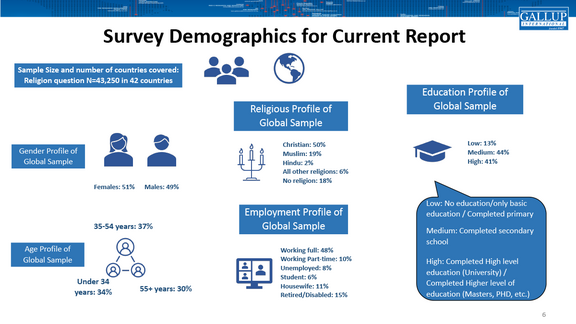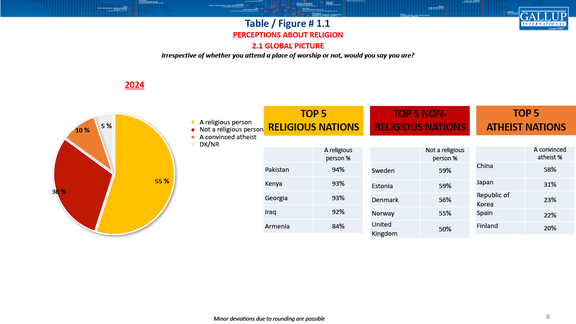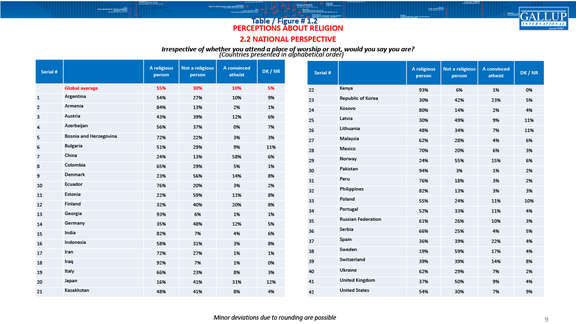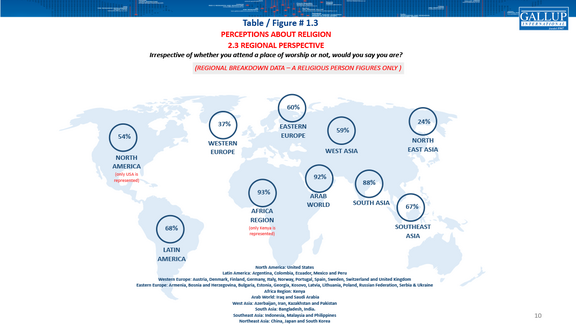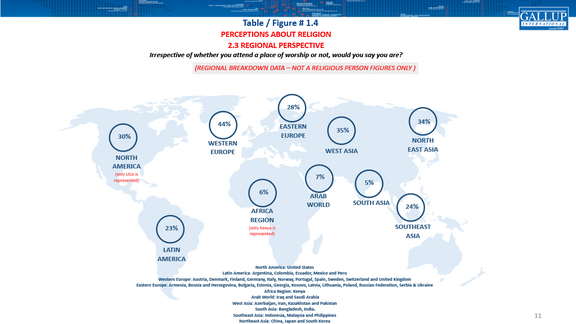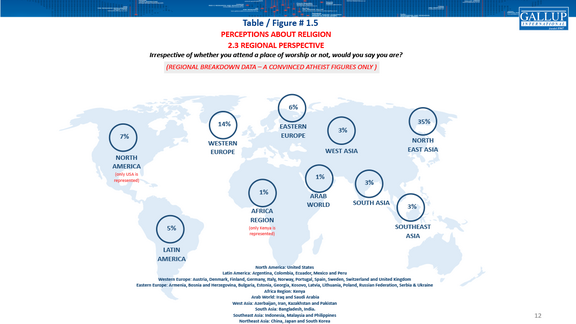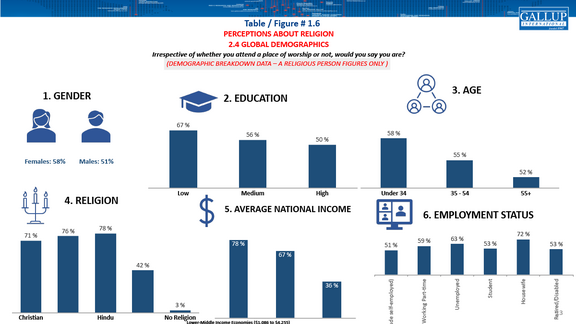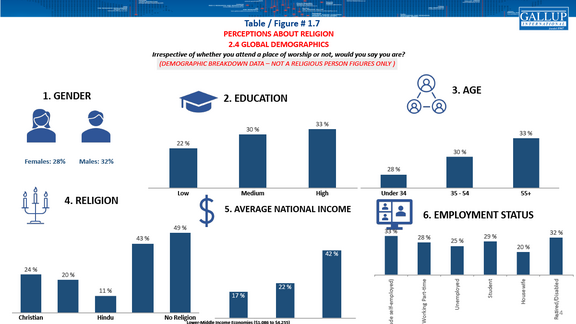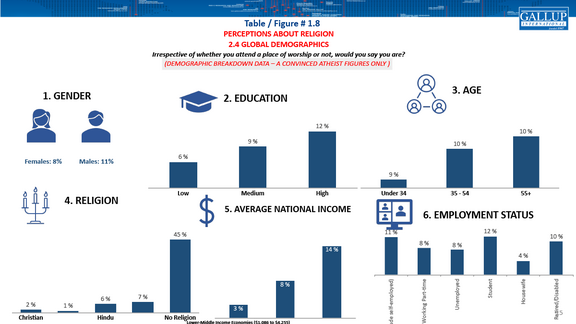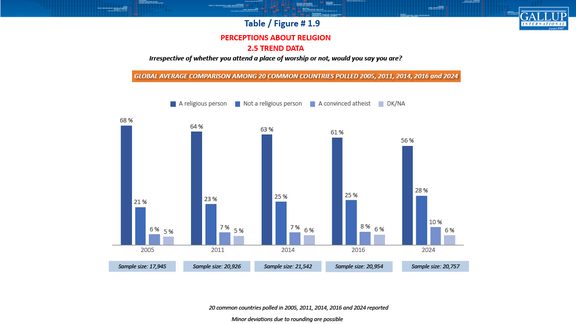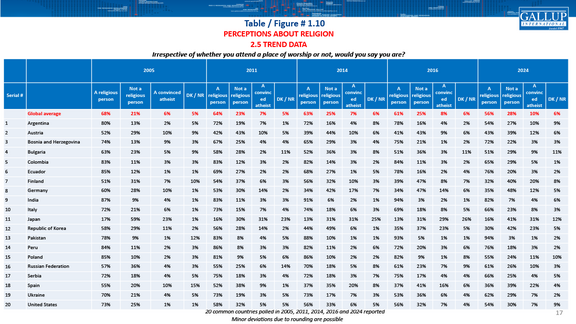A global end-of-year survey conducted across 42 countries with nearly 43,000 respondents resents a compelling picture of how religiosity varies widely across the world. The results show that while religion remains a powerful marker of identity in many regions, levels of belief differ significantly depending on geography, gender, age, education, and employment status.
Globally, 55 % of respondents identified themselves as religious, while 30 % said they were not religious, and 10 % declared themselves convinced atheists. This global average, however, masks striking regional variations. In Africa (represented by Kenya), 93 % of respondents identified as religious—the highest of any region surveyed. Similarly high levels were observed in the Arab World (92 %) and South Asia (88 %), underscoring the strong role religion continues to play in personal and societal identity in these areas.
In contrast, Western Europe emerged as the most secular region, with only 37 % identifying as religious. A substantial 44 % of respondents in this region stated they were not religious – the highest among all regions and 14 % identified as atheists. Northeast Asia followed closely, where just 24 % said they were religious, 34 % said not religious, while 35 % considered themselves atheists—highlighting a significant cultural divide between East Asia and much of the rest of the world. The United States, representing North America in the survey, showed a more moderate picture with 54 % identifying as religious, 30 % as not religious, and 7 % as atheists.
Key Findings
The key findings from the survey data are the following:
- Country-wise differences: In terms of country-level findings, the top five religious nations included Pakistan (94 %), Kenya (93 %), Georgia (93 %), Iraq (92 %), and Armenia (84 %). Meanwhile, Sweden (59 %), Estonia (59 %), Denmark (56 %), Norway (55 %), and United Kingdom (50 %) featured prominently among the most non-religious nations. The top five atheist countries included China (58 %), Japan (31 %), Republic of Korea (23 %), Spain (22 %) and Finland (20 %).
- Gender differences: Women are more likely to identify as religious than men—58 % compared to 51 %.
- Education differences: Education level has an inverse relationship with religiosity: 67 % of those with low education reported being religious, compared to 56 % with medium education and just 50 % of those with higher education (university level or above).
- National income differences: Religiosity is significantly influenced by a country’s average national income. In low-income countries, 78 % of respondents identified as religious, compared to 67 % in middle-income countries, and just 36 % in high-income countries. Conversely, atheism was most prominent in high-income settings, where 14 % identified as convinced atheists, compared to only 3 % in low-income countries. The proportion of people identifying as “not religious” also increased with national income—17 % in low-income countries, 22 % in middle-income, and 42 % in high-income countries.
Taken together, the survey findings reveal a world where religion continues to influence cultural norms and personal identity—though not uniformly. The interplay of region, education, and gender reveals complex dynamics that point toward both enduring traditions and rising secularism, depending on where you look. As global societies become increasingly interconnected, understanding these shifts in religious identity will be essential for policymakers, civil society, and global leaders alike. - Trend analysis (20 common countries): Between 2005 and 2024, global perceptions about religion have shifted notably. The proportion of people identifying as religious declined from 68 % in 2005 to 56 % in 2024, reflecting a steady global trend toward secularization. Meanwhile, the share of those identifying as not religious increased from 21 % to 28 %, and convinced atheists rose from 6 % to 10 %. These changes suggest a gradual but consistent move away from traditional religious identification over the two decades. Country-level data reinforces this trend, with highly industrialized nations such as Japan and Germany showing sharp rises in atheism and non-religiosity, while countries like Pakistan and India remain strongly religious, albeit with slight declines. This divergence points to a growing global polarization in religious identification, often aligned with levels of economic development and cultural change.
Commentary on poll findings by Michael Nitsche, President Gallup International Association in Vienna, Johny Heald, Board Member GIA in London and Bilal Gilani, Board Member GIA in Islamabad:
“These data reflect an evolving global landscape in which religious identity is both resilient and responsive to broader societal trends. Over the last two decades, belief systems have shifted significantly—particularly in high-income and industrialized countries—where secular and atheist identities have grown steadily. At the same time, many low- and middle-income regions remain bastions of religious adherence, indicating that faith continues to serve as a source of meaning and solidarity amid socioeconomic and political flux.”
Note to Editors:
Sample Size and Mode of Field Work:
A total of 43,250 persons were interviewed globally in 42 countries for this question. In each country a representative sample of around 1000 men and women was interviewed during October 2024 – February 2025 either face to face, via telephone or online. The margin of error for most country level surveys is between ±3 – 5 % at 95 % confidence level. For more details regarding methodology please contact: Bilal I Gilani, Board Member Gallup International on email: bilal.gilani@~@gallup.com.pk


